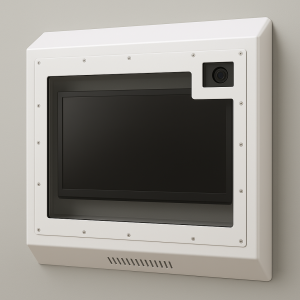In behavioral health facilities, safety and security go hand-in-hand with patient care. One of the most overlooked yet critical elements in maintaining this balance is the television system. A behavioral health TV enclosure with camera is more than just a screen protector—it’s a vital tool in ensuring constant observation, ligature resistance, and tamper-proof protection in high-risk environments.
Why Combine TV Enclosures with Cameras in Behavioral Units?

In psychiatric and mental health units, TVs can pose safety risks if not properly secured. Patients may attempt to harm themselves using exposed wires, metal brackets, or even the television itself. Traditional enclosures solve part of the problem by housing the TV in a ligature-resistant frame. However, adding camera-ready integration elevates that protection by enabling real-time monitoring.
Behavioral health staff can observe patients without invading their privacy, allowing for quick intervention if distress or behavioral escalation is observed. This fusion of safety and surveillance is essential in facilities prioritizing both patient well-being and staff security.
Benefits of Behavioral Health TV Enclosures with Camera Integration
1. Enhanced Observation Without Intrusion
These enclosures are designed with built-in camera windows – typically polycarbonate or anti-scratch acrylic – that allow CCTV or IP cameras to discreetly monitor patient activity. This helps staff identify agitation, aggression, or distress in time to act.
2. Ligature-Resistant and Tamperproof
The enclosure itself is built with sloped edges and reinforced steel, preventing patients from attaching cords, ropes, or clothing to any part of the structure. The locks are tamperproof, and all fixings are concealed, reducing opportunities for self-harm.
3. HIPAA and Privacy Compliant Design
While continuous observation is necessary, privacy concerns must also be addressed. These enclosures allow staff to monitor communal areas or shared rooms while still respecting individual dignity. Some models support privacy masking on camera feeds to meet regulatory requirements.
Technical Features to Look For
When choosing a behavioral health TV enclosure with camera, facilities should consider the following:
Shatterproof polycarbonate viewing windows
Anti-ligature sloped design on all sides
Built-in ventilation to prevent overheating
Mounting options for wall or corner placement
Cable management systems to hide wires
VESA compatibility for various screen sizes
Pre-drilled camera port with reinforced housing
Some enclosures even support networked video recording (NVR) or integration with existing nurse call systems.
Related Safety Solutions
Ligature-Resistant Clocks for Mental Health Units
Timekeeping is essential for structure and routine in mental health settings. Explore tamperproof clock enclosures built for high-risk zones.
Secure Noticeboards for Behavioral Facilities
Post schedules, calming imagery, or rules on enclosed noticeboards that prevent access to sharp pins or exposed corners.
Applications in Modern Behavioral Health Design
Facilities ranging from state hospitals to private residential treatment centers are now prioritizing behavioral health TV enclosures with camera capability as part of their foundational safety design. These units are used in:
Psychiatric acute units
Substance abuse recovery centers
Juvenile correctional facilities
VA hospitals and veterans’ homes
Autism and special needs classrooms
By integrating technology into patient rooms and communal areas safely, providers are creating environments that are both therapeutic and secure.
Final Thoughts
The need for continuous monitoring in behavioral health settings is no longer optional—it’s essential. A behavioral health TV enclosure with camera not only protects patients from harm but gives staff the tools they need to provide proactive, compassionate care.
As mental health design evolves, combining robust physical protection with smart surveillance is the new standard. Investing in the right enclosure is a small step toward big improvements in patient safety, legal compliance, and overall care quality.